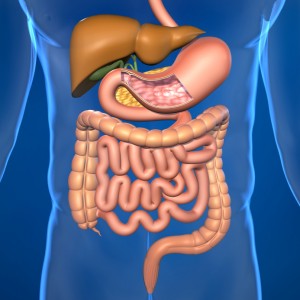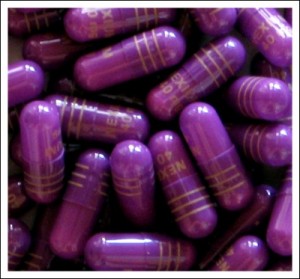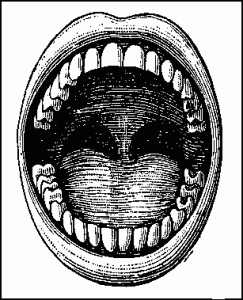The Road to Health is Paved with Good Intestines #4: The Stomach
 Last month our journey through the gastrointestinal tract took us from the mouth down the tube called the esophagus. As the journey continues in this the fourth blog in this series, we have come out of the esophagus and found our way into the stomach.
Last month our journey through the gastrointestinal tract took us from the mouth down the tube called the esophagus. As the journey continues in this the fourth blog in this series, we have come out of the esophagus and found our way into the stomach.
When most people think about digestion, the stomach is probably the first thing that comes to mind. The stomach is a muscular, elastic pear shaped bag that can comfortably hold about a quart of food. It is in the stomach where the real physical dis-assembly of the food you ate takes place.
The stomach has three tools that it uses to accomplish this. First it produces hydrochloric acid that breaks down the proteins in our food and kills bacteria that may have been growing on our food to prevent infection. Second it produces digestive enzymes that further help to rip apart proteins, fats, and carbohydrates. Third the muscular mechanical action of the stomach physically macerates the food into small particles allowing the acid and the enzymes to work even more effectively.
From the time that you eat a food, it typically takes 2 to 4 hours for the stomach to work on breaking it down before letting it continue on to the small intestine. By the time it is released into the small intestine it should bear no resemblance to the meal that you ate.
Unfortunately, there are many things that can impair this function from occurring optimally such as:
- Eating while you are under stress or eating without paying attention to what you are eating.
- Eating too fast and not chewing your food well.
- Taking antacid and acid blocking medications
- Eating too much
- Low stomach acid production
- Infection with the bacteria H. pylori
Some of the consequences of impaired stomach digestive function include:
- Stomach pain
- Reflux or heartburn
- Gas and bloating
- Nausea
- Constipation or diarrhea
- Nutrient deficiencies or insufficiencies
- Increased risk of developing food sensitivities
- Increase risk of developing chronic bacterial infections of the small intestine.
The stomach actually works better when it is not completely full. Have you ever tried to use your blender when it is too full? You end up with a big mess all over the kitchen and your smoothie doesn’t get blended very well. If the stomach is too full it can’t break things down very well. In addition pressure builds up and the stomach contents can find their way back up into the esophagus. When this happens it can cause the burning that we associate with heartburn.
In order to optimize he ability of your stomach to adequately break down you food and prepare it for its journey through the small intestine, I recommend the following:
- Try to eat in a calm, relaxed, mindful state. (See the first blog in this series for more details.)
- Chew your food thoroughly before swallowing. (See the second blog in this series for more details).
- Do not over eat. Eat only until you are about 80% full to allow your stomach room to do its work.
- Eat slowly to allow the stomach time produce stomach acid and enzymes.
- Avoid long term use of antacids or stomach blocking medications. If you have to take these daily, it is time to seek professional guidance to determine and fix the underlying issues.
- To help further stimulate the digestive function consider taking digestive bitters (see last month’s blog) or drink the juice of half a lemon in 3 to 4oz of room temperature water before you eat.
If symptoms persist, you may need to supplement with digestive enzymes or hydrochloric acid. Working with a practitioner who is knowledgeable about optimizing digestive function can be helpful in determining if these therapies may be helpful and how best to use them.
You may be wondering why the hydrochloric acid in your stomach doesn’t it just burn a hole right through it. Fortunately for us, the lining of our stomach is protected by a layer of mucous. However if that mucous layer breaks down it will allow the acid to burn a hole in the lining. This is what happens when someone develops an ulcer.
While it used to be though that most ulcers were caused by stress, it has since been found that there is a bacteria called Helicobacter pylori that is to blame. While most bacteria are killed off in the acid environment, H. pylori can thrive in it leading to irritation, inflammation, and ulceration of the stomach lining. When this happens, it not only hurts, but it also impairs digestion by decreasing stomach acid production and it impairs absorption of certain vitamins and minerals such as zinc and vitamin B21.
While treatment of stomach ulcers can often require the use of antibiotics, the licorice compound that I mentioned in last month’s blog (DGL) can often be helpful in restoring the mucous lining to the stomach and getting rid of the bacteria H. pylori. 1 to 2 tablets chewed before each meal can often helped to relieve symptoms and allow healing to take place.
Severe cases of ulceration can lead to blood loss and be a serious health concern. If symptoms persist or get worse, seek care from your health care practitioner.
Now that our food has been effectively broken down by the stomach, in our next blog we will look at how we absorb those nutrients in the small intestine and what can cause that ability to be impaired.



